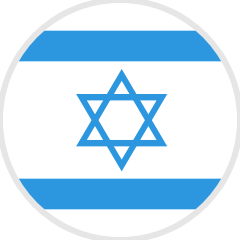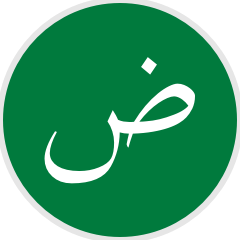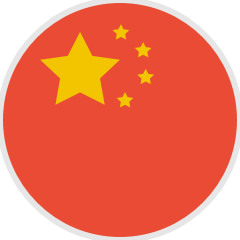Updated 10/12/2022
A tech journalist recently asked me how Fluent Forever was different from existing products like Duolingo or Rosetta, and I realized that I didn’t have a short answer to that question. So I decided to make a short video that sums up the key differences between Fluent Forever and the many other tools out there.
If you’re looking for an even shorter summary than the video below, the one-sentence summary is:
Fluent Forever is a translation-free method rooted in neuroscience that provides the fastest road to fluency with the best long-term retention.
Once you’ve watched the above video, here’s an explanation of my method in some more detail.
The Fluent Forever method explained
Origins and where we’re headed
I’ve been working on the Fluent Forever method for the last nine years.
Back in 2010, I needed a way to learn French extremely fast. I had enrolled in a French immersion program, cheated on the online placement test, and got myself stuck in a situation where I was going to get in serious trouble if I couldn’t back up my test results with conversational skills in three months.
So I cobbled together the first version of the Fluent Forever method out of various online tools, discovered that it worked far better than I expected, and reached fluency in French (C1 fluency, to be precise) in five months.
Then the optimization process began. Every time I learn a new language, every time I discover a new tool, and every time someone emails me with a new way of learning, I find ways to tweak and improve the overall method.
In this article, I want to give you a short summary of where we’re at right now, and how I think you should approach your next language. I’ll also chat a bit about why I’m making each suggestion, so that this isn’t just another “do this because I say so” article.
Stage 1: Rewire your ears
1–3 weeks
Ever met someone with a foreign-sounding name, and then forgotten their name immediately thereafter? This happens because your ears hard-wired themselves to your native language(s) when you were one year old. It’s a super-helpful adaptation that allows you to speak your native language well, but it’s unfortunately terrible for your ability to remember foreign words.
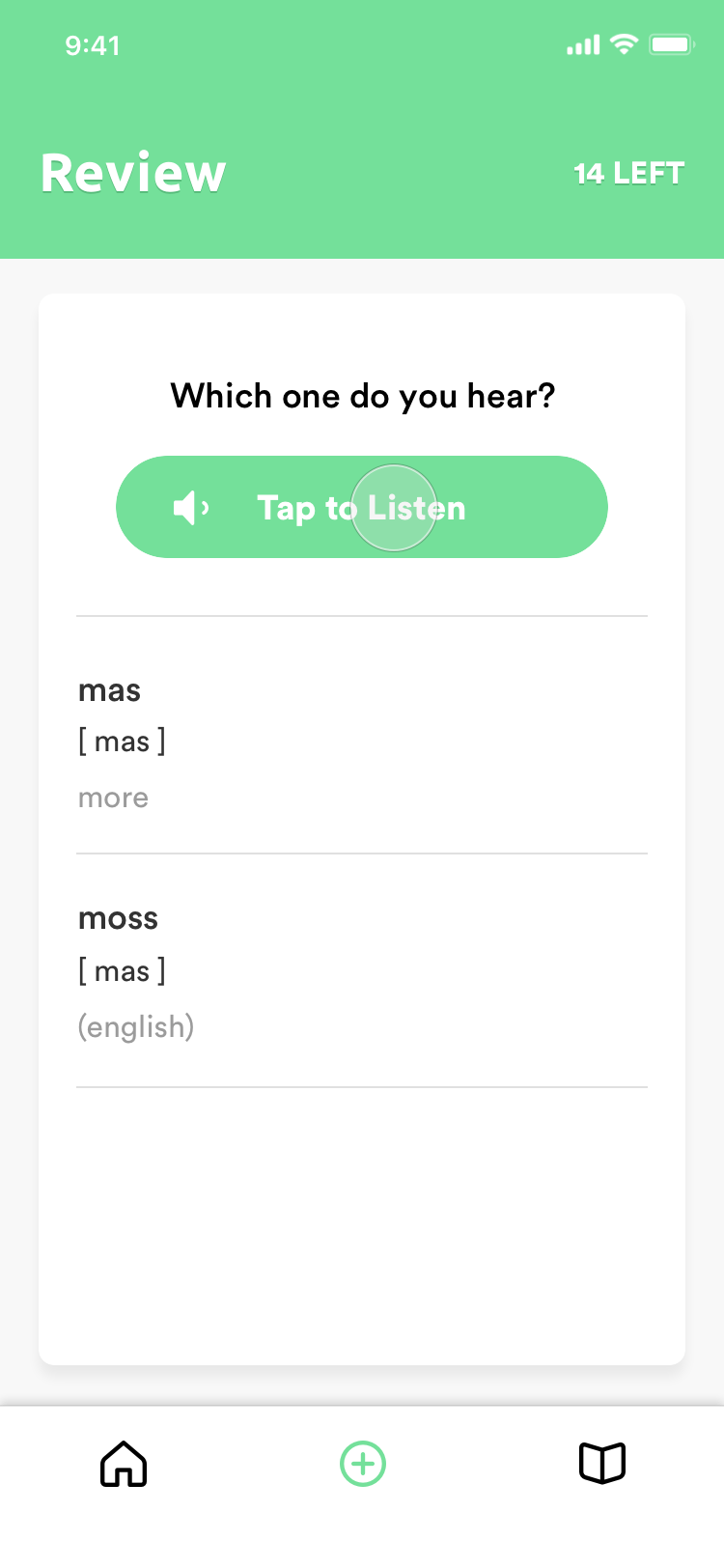
Your first job, then, is to rewire your ears so that foreign words stop sounding foreign. This takes 2–3 weeks. If you’re using our app, we’ll take you through ear training exercises that ask you to compare similar-sounding pairs of words.
As you learn to hear these new sounds, we’ll help you customize a bunch of audio/visual flashcards that teach you the spellings that produce those sounds.
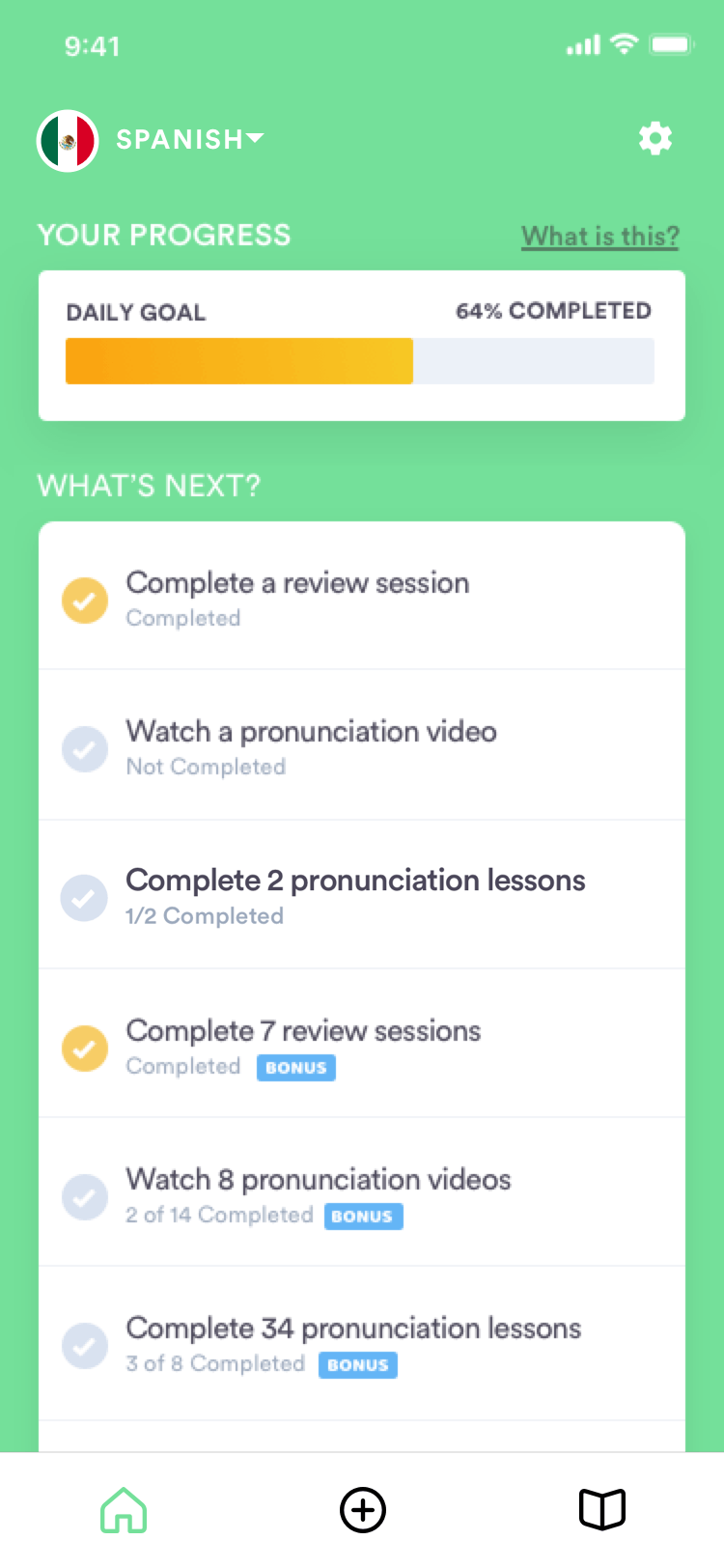
And if your new language uses a new alphabet, we’ll teach you all the letters and helpful mnemonics to retain them long term.
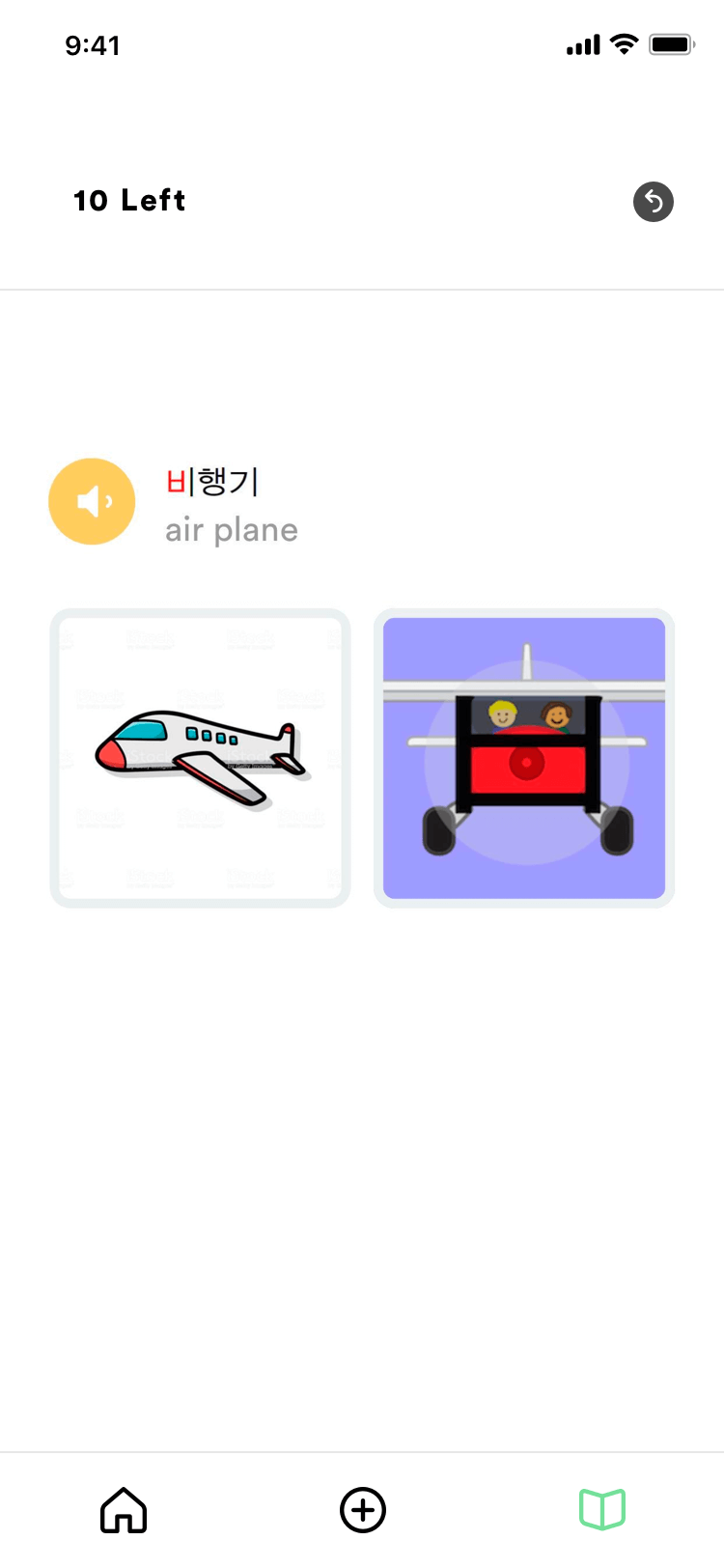
Stage 2: Begin learning your base vocabulary with pictures, not translations
3+ weeks
With ear training out of the way, your next goal is to start training yourself to think in your target language.
Most people have a habit of memorizing translations when learning new vocabulary – it’s a habit many of us learn through language classes in school – and that’s a habit worth breaking as early as possible.
We’ve created a list of 625 base vocabulary words that are both common (dog, not elephant) and visual (body, not although). They’re words that are easy to learn using pictures instead of translations.
If you’re using our app, we’ll guide you through a process of choosing those pictures and building up a set of customized flashcards to internalize these words.
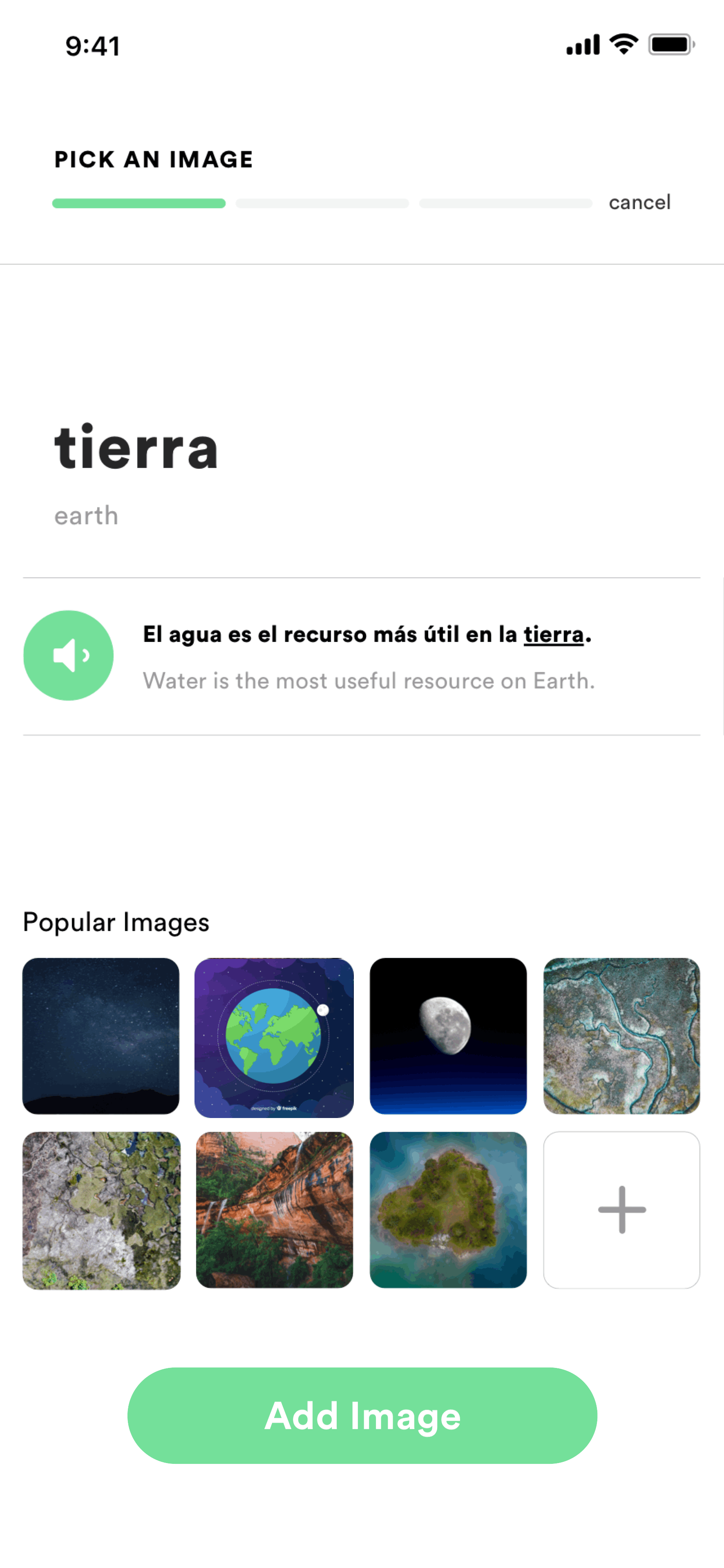
You can finish this stage as soon as you feel comfortable starting to learn grammar in Stage 3.
Some folks will reach that point after 20–30 words, and some will want to learn most or all of the 625 base vocabulary before they move to the next stage.
It’s not terribly important which side of the spectrum you fall into. As long as you’re enjoying yourself and your daily studies aren’t focused on memorizing translations, then you’re going to be making consistent progress.
Stage 3: Learn grammar using sentences that are relevant to you
12+ weeks
As you become more comfortable learning words using pictures, rather than translations, you’ll find that you’re ready to start learning grammar.
Now, ‘grammar’ tends to be a scary, dangerous topic for many people; it brings back memories of memorizing confusing conjugation charts and arbitrary rules. But in the context of Fluent Forever, all I really mean by ‘grammar’ is ‘learning words in sentences.’
Suppose you learned “perro” [dog], “gato” [cat], and “perseguir” [to chase] back in Stage 2, using pictures instead of translations.
Suppose you ran into a sentence like this one:
“Ayer, mi perro persiguió a mi gato.”
[Yesterday, my dog chased (to/towards) my cat.]
If you found this sentence interesting, then you could use it to learn a bunch of things:
- Vocabulary (“ayer” [yesterday], “mi” [my], “a” [to/towards])
- Word forms (“persiguió” [chased])
- Word order
At first, you’re going to want to have a translation available to help you figure out which word is doing what, and that’s a good use of translation. It gives you your bearings in your target language.
But the good news is that you don’t need that translation after you’ve gotten your bearings. Once you understand how each word in that sentence works, then we’re going to help you build customized flashcards that rely upon pictures and the other words in the sentence, to help you remember each word.
Those flashcards look like this:
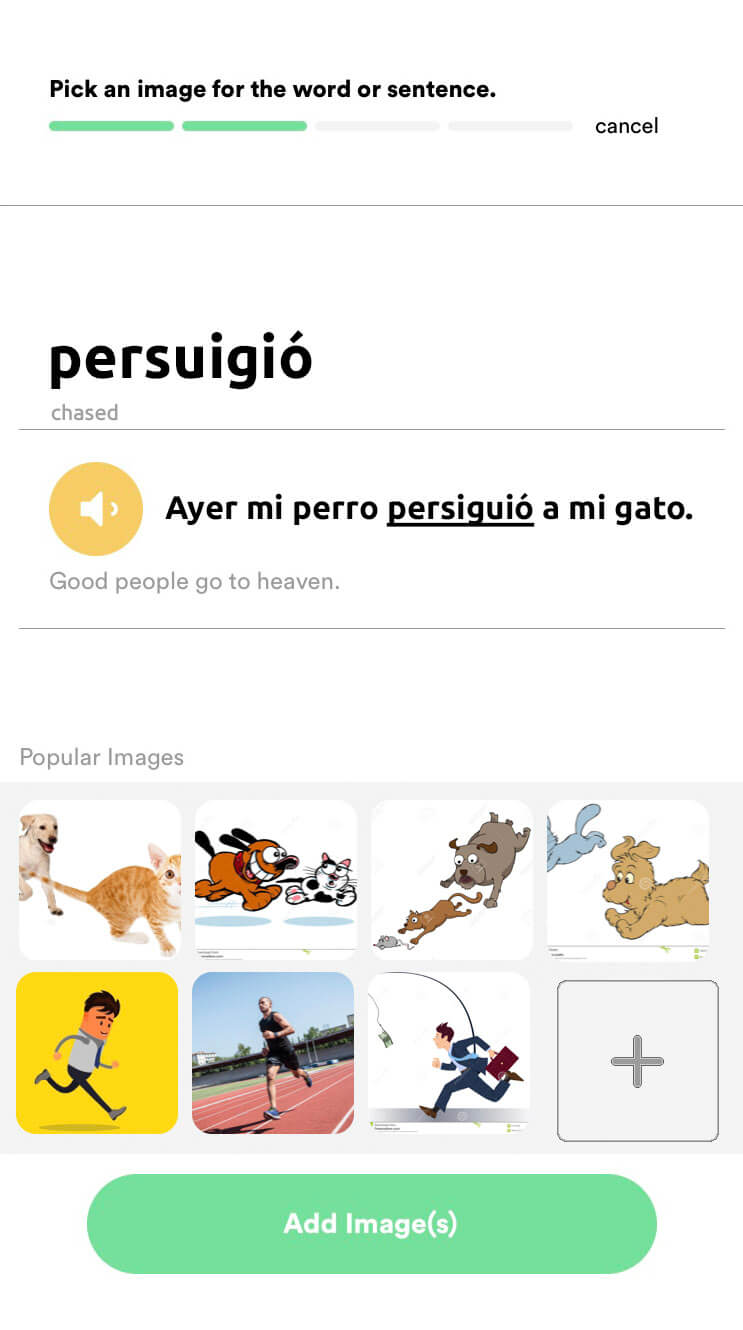
Because you do the work of decoding that sentence from the translation, you choose the words you want to learn, and you choose the images for those words, those flashcards will allow you to internalize even abstract vocabulary without constantly drilling and re-memorizing translations.
This is good news because it means that you can spend your time practicing how to think in your new language, even as the vocabulary you’re learning is no longer restricted to simple, visual words.
Once you get to this stage, you’ll want to stay here for a good, long time. This is where you internalize the language and build up your ability to think in a new way.
In our app, you’ll be able to choose from 1,875 sentences spanning a wide variety of difficulty levels. We’re asking you to choose the sentences you care about because learning random sentences about random, uninteresting topics is a good way to get bored, and boredom is fatal to learning.
Check out our honest app review for real user testimonials on the Fluent Forever app, and to find out more about this effective fluency tool.
Stage 4: Practice your speech to fluency with native tutors
12+ weeks
Speech isn’t a matter of knowing all the words in your new language. Speech is actually a skill in its own right; it’s learning to jump over holes in your vocabulary and find alternate ways to say something when you’re missing the perfect word.
You build this skill by talking in your target language with native speakers and, as much as you can, stubbornly refusing to switch to your native language.
There is a really effective way to use tutors in our Live Coaching program: namely, you work with your very own coach to help you build personalized example sentences that you use during the week to learn new vocabulary. This is advantageous in a few ways:
- You have a constantly changing source of conversation topics (each new vocabulary item will prompt a new discussion about how best to use it in a sentence),
- You get someone who can help you understand all the bits and pieces of each sentence, and
- Every sentence you learn is as personal as it could possibly be. It’s already easy to learn sentences that you’ve chosen, but it’s far easier to learn sentences that you’ve created.
Check out this comprehensive guide for all you need to know about our language Coaching, and how it can help get you to fluency fast.
How do you know when you’re ready for Stage 4? Honestly, the earlier the better. The more exposure you have to native speakers, the easier it will be to internalize your language’s grammar and vocabulary, and the faster you’ll develop your speaking skills.
If you’d like to get started today, download our app and sign up for Live Coaching. I think you’ll be pleasantly surprised at your progress. 🙂
[shareaholic app="share_buttons" id="28313910"]













